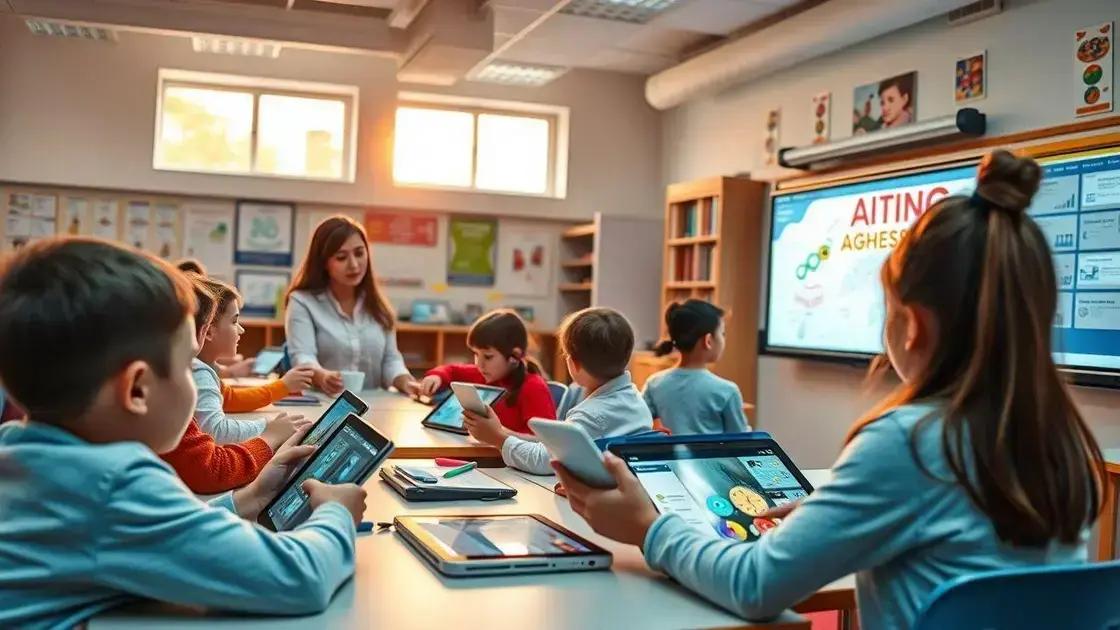AI integration in special education classrooms: a game changer

AI integration in special education classrooms enhances personalized learning, improves communication aids for students with disabilities, and empowers educators with data-driven insights, despite challenges like costs and training needs.
AI integration in special education classrooms is opening doors to personalized learning experiences. Have you considered how these tools can empower students with diverse needs? Let’s dive into the transformative impact on education.
Understanding the role of AI in special education
Understanding the role of AI in special education is crucial for enhancing learning experiences for students with diverse needs. By integrating advanced technologies, educators can provide personalized support that meets individual learning styles.
What is AI in Education?
AI in education refers to the use of algorithms and data to support teaching and learning. It helps educators analyze student performance, manage classroom activities, and tailor interventions effective for each learner.
How AI Supports Special Education
AI tools can identify specific challenges faced by students with disabilities. For instance, speech recognition software assists those with verbal communication issues. Visual recognition tools help in developing educational materials that cater to the individual.
- Personalized learning plans can be developed through AI.
- AI can adapt lessons in real-time based on student engagement.
- It offers teachers insights into student behaviors and learning patterns.
This enables timely interventions and a better learning environment. Moreover, AI can assist educators by reducing administrative tasks, allowing them to focus more on teaching rather than paperwork.
Technology such as virtual reality (VR) and augmented reality (AR) can create immersive learning experiences. These tools are particularly beneficial for students with sensory processing disorders. Instead of traditional methods, AI allows for interactive learning that resonates more with these learners.
Examples of AI Applications in Special Education
There are several AI applications currently transforming special education. Programs displaying visual prompts can help with communication. Additionally, apps that adapt materials based on progress can maintain student motivation and engagement.
- Adaptive learning technologies.
- AI-powered tutoring systems.
- Tools for visual and auditory feedback.
These applications are vital for creating a rich learning experience. Understanding these systems sheds light on how AI integration is reshaping education for everyone.
Benefits of AI for learners with disabilities
The benefits of AI for learners with disabilities are significant and can transform educational experiences. By implementing AI technologies, schools can tailor learning to each student’s unique needs, paving the way for greater inclusion and success.
Personalized Learning Experiences
AI can analyze individual learning styles and adapt materials accordingly. This personalization makes education more accessible for students with various disabilities. For instance, AI can modify assignments based on a student’s pace and understanding, providing timely feedback that helps them improve.
Enhanced Communication Tools
Communication is vital in education. AI-powered tools can help students who struggle with verbal communication express their thoughts and ideas. Applications like speech-to-text software allow students to participate more fully in classroom discussions.
- Text-to-speech applications for reading assistance.
- Augmented communication devices for non-verbal students.
- Interactive AI chatbots providing instant support.
By removing barriers to communication, students can engage more comfortably with their peers and teachers. This enhanced interaction fosters a sense of belonging and builds confidence.
AI also helps in monitoring progress. Educators can use AI systems to track how students with disabilities are performing over time. This data allows for evidence-based adjustments to teaching methods, ensuring that every student stays on track.
Supporting Teachers and Reducing Workload
Teachers face numerous challenges when supporting students with disabilities. AI can help alleviate some of these pressures by automating administrative tasks and providing insights into student behavior and performance. With AI, teachers can spend more time focusing on instruction and individualized support.
- Automated grading systems for quicker feedback.
- Assessment tools that adapt to student needs.
- Resource recommendations based on specific challenges.
AI integration allows educators to create a more effective learning environment, enabling all students to thrive. By highlighting these benefits, we can see how vital AI is in promoting equality within the educational landscape.
Tools and technologies for implementing AI

Using the right tools and technologies for implementing AI in special education can significantly enhance learning outcomes. Various applications and platforms are available that cater specifically to the needs of students with disabilities.
AI Tools for Learning Enhancement
Numerous AI tools help customize and enrich educational experiences. For instance, AI-driven educational software can analyze student interactions, allowing teachers to adjust lessons accordingly. These tools adapt content, making it accessible for all learners.
Speech Recognition and Text-to-Speech
Speech recognition tools convert spoken words into text, assisting students who struggle with writing. Meanwhile, text-to-speech software allows learners to hear written content, which is beneficial for those with visual impairments or reading difficulties.
- AI-powered communication devices for non-verbal students.
- Interactive software that personalizes quizzes and assessments.
- Virtual assistants programmed to provide educational support.
The integration of these tools enables teachers to provide tailored educational experiences that reflect each student’s unique strengths and weaknesses. Engaging applications that use gamification techniques can motivate students and make learning enjoyable.
Data Analytics Platforms
Data analytics platforms play a crucial role in monitoring student progress. These platforms compile data from various tools, providing educators with insights into individual performance trends. This analysis can help identify areas needing improvement, facilitating targeted interventions.
- Dashboards that visualize student learning metrics.
- Tools for tracking progress and setting goals.
- Systems for early identification of learning challenges.
With effective analytics, educators can make informed decisions about instructional methods, promoting better outcomes for all learners. Overall, the right combination of AI technologies will support educators and empower students in special education.
Real-world examples of AI in special education
Real-world examples of AI in special education showcase how technology can effectively support diverse learning needs. Schools and institutions around the world are adopting AI solutions to enhance teaching and learning experiences for students with disabilities.
Case Study: AI in Communication
One prominent example is the use of AI-driven communication devices. Schools have implemented systems like VocaTool, which help non-verbal students communicate more effectively. These devices use machine learning to recognize patterns in a student’s thoughts and translate them into speech, fostering greater interaction and engagement.
Personalized Learning Platforms
Another example is the adaptive learning platform, Smart Sparrow, used in various classrooms. It customizes lessons based on individual student performance, allowing educators to tailor instruction for students with learning disabilities. By analyzing student responses, the platform suggests personalized pathways to enhance learning.
- Example 1: VocaTool for communication assistance.
- Example 2: Smart Sparrow for adaptive learning.
- Example 3: Ghotit for writing support.
Similarly, Ghotit is an AI writing assistant designed for students with dyslexia and dysgraphia. It helps them improve their writing skills by providing context-sensitive spelling and grammar suggestions. This tool has empowered many students to express themselves more freely and confidently.
AI in Behavior Tracking
AI is also playing a role in behavior management. For instance, some schools use AI systems to monitor student interactions and behaviors in real time. Programs like ClassDojo allow teachers to track student behavior, encouraging positive conduct and providing instant feedback.
- Example 4: ClassDojo for behavior tracking.
- Example 5: AI-analyzing classroom interactions.
- Example 6: Personalized feedback for students.
These systems help educators understand their students better, allowing for personalized support and intervention when necessary. Overall, these real-world examples illustrate the transformative potential of AI technology in creating inclusive and effective educational environments.
Challenges of integrating AI in classrooms
The challenges of integrating AI in classrooms are significant and require careful consideration. Although AI can enhance educational experiences, several obstacles must be addressed to ensure successful implementation.
Cost of Technology
One of the primary challenges is the cost associated with acquiring AI tools and infrastructure. Many schools face budget constraints that prevent them from purchasing advanced technologies. Additionally, ongoing maintenance and updates can strain financial resources.
Training for Educators
Another critical issue is the need for adequate training for teachers. Instruction on how to effectively use AI tools is essential for maximizing their potential. Without proper training, educators may feel overwhelmed or unsure about how to integrate these technologies into their teaching.
- Access to professional development programs.
- Creation of user-friendly AI tools.
- Collaborative networks for sharing best practices.
Moreover, the lack of familiarity with AI among educators may hinder its adoption. Many teachers are used to traditional methods and may be resistant to changing their approach.
Data Privacy Concerns
Data privacy is another pressing challenge. Educational institutions must ensure student data is protected. With AI systems collecting and analyzing data, there is a risk of breaches if strong security measures are not in place. Schools must navigate legal and ethical issues related to student information.
- Understanding regulations like FERPA.
- Implementing secure data storage solutions.
- Educating stakeholders about data protection.
Navigating this landscape requires a transparent approach, ensuring that parents and students feel safe using AI technologies. Additionally, accountability for AI decisions in education must be clarified to prevent bias.
Equity and Access
Equity in access to technology is also a concern. Not all students have equal access to AI tools, especially in underfunded schools. This digital divide can exacerbate existing inequalities in education.
- Providing equitable access to all students.
- Ensuring infrastructure supports AI technologies.
- Encouraging partnerships with tech companies.
Addressing these challenges is essential for ensuring that AI integration in classrooms is successful, ultimately benefiting all students.
FAQ – Frequently Asked Questions about AI in Special Education
What are the main benefits of integrating AI in special education?
Integrating AI in special education enhances personalized learning experiences, improves communication for non-verbal students, and provides educators with valuable insights into student progress.
What challenges do schools face in adopting AI technology?
Schools often encounter challenges such as high costs for AI tools, the need for adequate training for teachers, data privacy concerns, and ensuring equitable access to technology for all students.
How can teachers be trained to use AI effectively?
Teachers can be trained through professional development programs, workshops, and collaborative networks that focus on best practices for integrating AI tools into their teaching.
What role does data privacy play in using AI in education?
Data privacy is crucial as AI systems often collect and analyze student information. Schools must implement strong security measures to protect sensitive data and comply with regulations.





